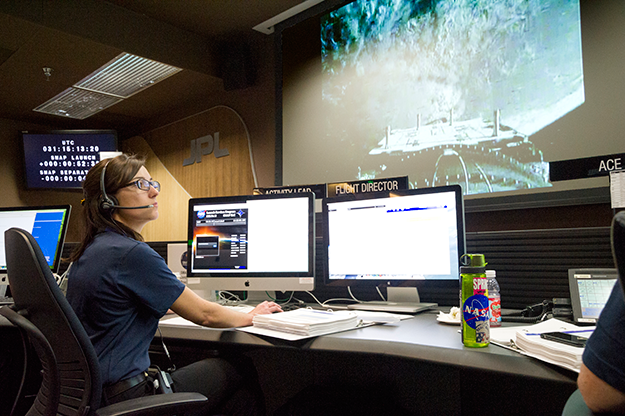Tiger of the Week: Sarah Sherman ’08, Studying Earth From Space
When the Soil Moisture Active Passive (SMAP) satellite launched smoothly on Jan. 31, Sarah Sherman ’08 had cause to celebrate. As the mission’s launch-phase lead at the Jet Propulsion Laboratory (JPL), the Caltech-managed NASA center in Pasadena, Calif., Sherman was in charge of putting procedures and contingency plans into place, as well as executing dress rehearsals of the launch.
SMAP uses the radar and radiometer it has on board to gather soil moisture data, which can be used to monitor droughts, predict floods, and improve weather forecasts, among other things. Sherman is now doing operations for the satellite, which involves being on console as a systems chair and overseeing the 90-day commissioning phase that precedes the beginning of the three-year science, or data-collection, phase.
Perhaps that seems like a lot of responsibility for someone who hasn’t yet hit 30. In reality, however, Sherman has been working on SMAP for almost seven years, since the summer after she graduated from Princeton. Before that, she worked in the summers of 2006 and 2007 as a Caltech research fellow analyzing wind models of Titan and developing control algorithms to steer a hot air balloon in its atmosphere. Her next project will be as a mechanical engineer on the Sample Caching System of the Mars 2020 Rover.
At Princeton, Sherman studied mechanical and aerospace engineering and was a coxswain for the men’s lightweight rowing team. At first, she said, she envisioned herself working for a car or aircraft company as a mechanical engineer, though she had also always liked aerospace engineering. Princeton’s joint degree program in the two meant that she didn’t have to choose. She didn’t take many spacecraft design classes as an undergraduate, but after spending two summers in Pasadena, Sherman fell in love with the city and with the work she was doing. A presentation she did at Caltech about her senior thesis, which she wrote about Titan, helped her land her current job.
While at Princeton, Sherman also learned valuable lessons outside of the classroom. As a crew coxswain, she said, “You have to show a lot of leadership skills — that’s just inherent in the job. And I think that that actually helped me just as much as the classroom education did.”
Aerospace is a male-dominated world, she added. “Having been in engineering, as well as a male sport as a woman, I feel like I was able to hold my own, maybe, a little bit better, than if I had not done that,” she said.














No responses yet